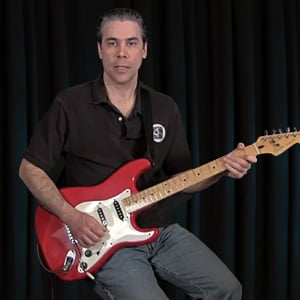Description
In this lesson we will apply the concept of a triad chord voicing and subsequent chord inversion voicings to minor chords.
Minor chords are defined as the 1st, 3rd & 5th note of a minor scale played (or regarded as a unit) at the same time. In this example we will use the C minor scale to isolate a C minor chord.
C minor scale:
C (1) - D (2) - E-flat (3) - F (4) - G (5) - A-flat (6) - B-flat (7)
C minor chord:
C (1) - E-flat (3) - G (5)
Played together this results in the triad of a C minor chord played in it's most basic form. Pitchwise, the lowest note is the root note, the C, the 1st scale degree, so this is our Root Position C minor chord because the notes are arranged low to high 1st, 3rd & 5th.
If we leave off the bottom note and make the 3rd the lowest note pitchwise, then play the 5th higher and play the 1st an octave higher than originally played, the result is still the same chord, it is still a C minor chord, but it is a different voicing of the C minor chord. The result is called a First Inversion Triad.
C minor chord in First Inversion:
E-flat (3) - G (5) - C (1)
Let's do this again, but this time leave off two of the bottom notes, the 1st and the 3rd. Now the 5th is the lowest note pitchwise and the 1st and 3rd are both played an octave higher than originally played. Again, we have the same chord, but a different voicing. This results in what is called a Second Inversion Triad.
C minor chord in Second Inversion:
G (5) - C (1) - E-flat (3)
If we do this again we will move the lowest note, now the 5th, up an octave and we will be right back where we started at a Root Position Triad chord voicing. Except, now, the entire chord will be up an octave from the original location!
C minor chord in Root Position:
C (1) - E-flat (3) - G (5)
I also re-emphasize the same two important concepts that major triad inversions opened up. This time the same ideas apply to minor chord voicings.
The first is that by using inversions we can make our chords, and therefore our music, much more interesting; more rich, complex and beautiful. We can start to look at using chords not simply as static shapes, but as three simultaneous voices that each have their own unique qualities in the overall fabric of the music.
The second is that these different voicings are very powerful tools once we understand and apply them because they enable us view and use the entire fretboard. We can play any given chord in any location or register (low or high pitch) by isolating the 1st, 3rd and 5th anywhere on the fretboard we can find them.
Lesson Info
Tutorial Lessons
- Intro to Triads & Inversions: Lesson 1
- Intro to Triads & Inversions: Lesson 2
- Intro to Triads & Inversions: Lesson 3
- Intro to Triads & Inversions: Lesson 4
- Intro to Triads & Inversions: Lesson 5
- Intro to Triads & Inversions: Lesson 6
- Intro to Triads & Inversions: Lesson 7
- Intro to Triads & Inversions: Lesson 8
- Intro to Triads & Inversions: Lesson 9
- Intro to Triads & Inversions: Lesson 10
- Intro to Triads & Inversions: Lesson 11
